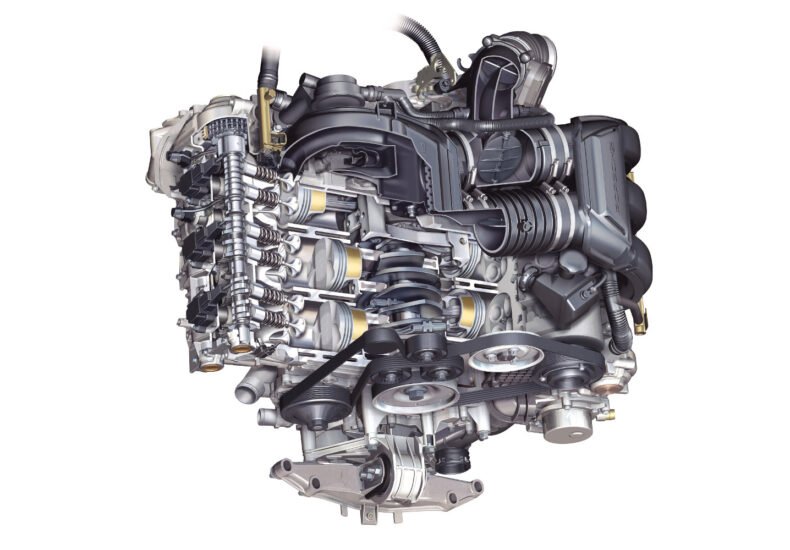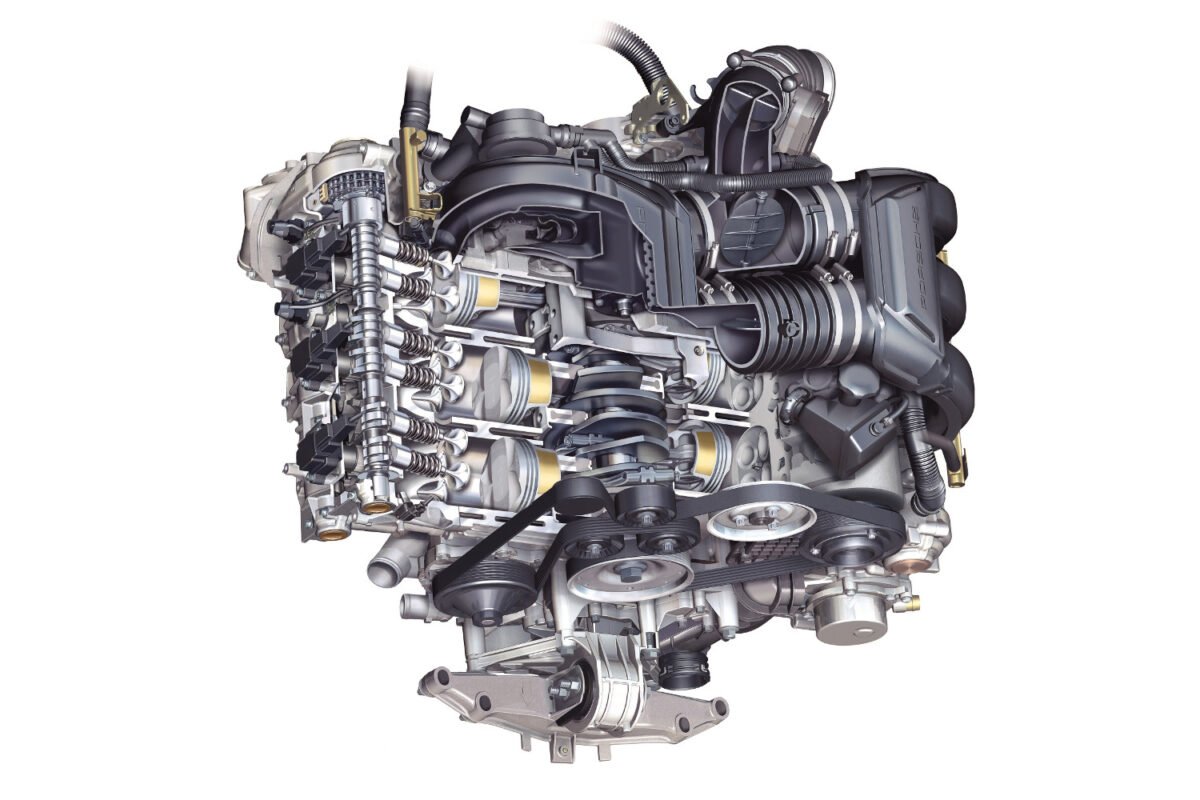
3.4-Litre – The 987 Cayman S Engine (2005)
The first ever 987-generation Porsche Cayman S was launched in 2005. It was powered by a six-cylinder 3.4-litre aluminium boxer engine. Let’s check some of the specs.
987 Porsche Cayman S Engine
The engine of the 987 Porsche Cayman S is both powerful and lightweight, with a low center of gravity. The two-piece block is die-cast in lightweight aluminum with integrated oil and water channels. This solution eliminates the need for drilling or external hoses, which are possible sources of failure.
A cross-flow cooling system channels coolant separately to each individual cylinder, so that all six cylinders operate within the same temperature range. Consistent temperatures reduce the chance of pre-ignition knocking, extend valve life, improve fuel economy, and lower emissions. And because the coolant channels are cast into the block, routine maintenance is significantly reduced.
An integrated dry-sump system ensures consistent lubrication. Oil is extracted by two scavenger pumps, one dedicated to each cylinder head. Narrow return lines de-foam the oil before it is collected in the integral sump. A third pump feeds the oil back to the lubrication points, starting the cycle anew. The result is consistent lubrication, even in sweeping high-speed turns.
VarioCam Plus
The engine of the Cayman S is equipped with the VarioCam Plus system that continually adjusts valve timing for optimum performance. Key benefits include increased power and torque at all engine speeds, smoother running, better fuel economy and fewer exhaust emissions.
The high voltage system with separate coils on each plug assure perfect ignition every time. With no central coil, there is no need for leads, a common source of electrical faults. All six coils are directly controlled by the engine management system, which can alter ignition timing if necessary.
Breathing is optimized by a twin-flow intake pipe, with valves that open and close at predefined engine speeds. A resonance pipe connecting the twin plenum chambers is used to alter the geometry within the manifold. The resulting vibration of the air molecules improves cylinder charging. The result of all this controlled breathing: higher torque at low rpm, a flatter torque curve and greater top-end power.

3.4-Litre Technical Specifications
- Six-cylinder aluminium boxer engine
- Water-cooled
- Engine block and cylinder heads made of aluminium
- Four overhead camshafts
- Four valves per cylinder
- Adjustment of valve timing on the intake camshaft and modification of valve lift (VarioCam Plus)
- Integrated dry sump lubrication
- Engine oil: 9.7 litres (2.13 Imp gals)
- Coolant: 22.3 litres (4.91 Imp gals)
- Bore: 96 mm (3.78″)
- Stroke: 78 mm (3.07″)
- Capacity: 3386 cm3
- Compression ratio: 11.1:1
- Engine output: 217 kW (295 bhp) at 6,250 rpm
- Maximum torque: 340 Nm (251 lb-ft) at 4,400-6,000 rpm
- Output per litre: 64.1 kW/87.2 bhp
- Max engine speed: 7,300 rpm
- Fuel grade: Premium plus (RON/MON 98/88), unleaded
- Electrical system: 12 V, 2100 W alternator, battery capacity 70 Ah
Check also
2006 Porsche Cayman S – 10 Fast Facts
You may also like



Most Popular Today
- What is the 2024 Porsche 911 S/T?
- Chronograph 1 – 50 Years 911 Turbo Edition
- Porsche 911 GT3 RS Tribute to Jo Siffert
- 2025 Porsche 911 GT3 PDK (992.2) Specs
- Rome Red Metallic 1990 Porsche 911 Reimagined by Singer
- Take a Look – 2015 Porsche Boxster GTS Exterior
- What is the T-Hybrid?
- Quick Guide to the Type 964
- 2006 Porsche 911 Carrera S Cabriolet – 10 Fast Facts
- Carrara White Metallic 2018 Porsche 718 Boxster GTS
